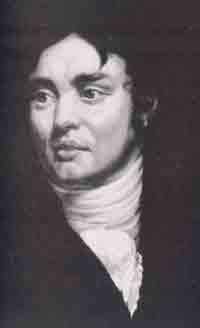Samuel Taylor Coleridge (Samuel Taylor Coleridge)

Poet, Critic, Philosopher. Born in Ottery St. Mary in Devonshire England, Coleridge was the youngest of 10 children born to John Coleridge, a minister, and his wife, Ann Bowden. In this crowed household, it was reported that Coleridge led to a less than idyllic childhood. It was made worse in 1781 by the death of his father, a man he idolized. He was sent to study at a London charity school and eventually stayed with a maternal uncle. As an adolescent, Coleridge lost two of his siblings. He himself became ill, and it is believed that his use of Laudanum, which was a commonly used drug at the time, may have set him on the road to addiction. Later in his life he would be identified as an opium abuser, and he stated that one of his most famous poems, “Kubla Khan,” was inspired by visions seen while under the influence. In 1791, Coleridge enrolled in Jesus College at Cambridge. Except for a brief spell in the royal dragoons in 1794 to either escape from bad debt or his failure in romance, he remained at Cambridge until 1795 when he met Robert Southey, a fellow poet. Southey and Coleridge shared similar political ideas. They discussed various projects they thought about doing together but never followed through on. Southey has been credited with introducing Coleridge to William Wordsworth in 1795. Coleridge became friends with Wordsworth and his sister, Dorothy, and their relationship lead to the creation of one of the most seminal works in English poetry, “Lyrical Ballads.” This famous partnership is detailed in the 2000 English film “Pandaemonium” (which starred John Hannah as Wordsworth and Linus Roache as Coleridge). While Coleridge had married Southey’s sister-in-law, Sarah Fricker, it was not apparently for love. It wasn’t until he met Sara Hutchinson, Wordsworth’s sister-in-law, that he would have that experience. Eventually he would obtain a legal separation from his wife and would go for long periods of time without seeing his three children. Coleridge managed to maintain his friendship with Wordsworth for several years but eventually this would fall by the wayside as he slipped deeper into his opium addiction. The addiction was fueled by pain he was suffering from a variety of illnesses. Unable to kick the habit, he sought refuge in 1816 with physician James Gillman. He would remain there for most of the rest of his life becoming, at times, something of a recluse. Despite this Coleridge, did manage to have a career. Aside from poetry, he became interested in politics, theology, and philosophy producing several works on these subjects. He, in fact, lectured on Immanuel Kant to the public. He also wrote and spoke about the works of Shakespeare, on whom he was considered a leading authority. He wrote for magazines, publishing two of his own. He was also famous as a conversationalist. Coleridge attracted a wide variety of admirers including many well-known personages of the time such as the Wedgwood Family (who would give him some patronage). He was invited to join Royal Society of Literature and became recognized as the leading critic and essayist of his day. By 1834, his health had declined considerably, and he died of heart failure on July 25th of that year in the London neighborhood of Highgate. Coleridge was also the author of one of the most famous poems in the English language, “The Rime of the Ancient Mariner.” (bio by: Catharine) Family links: Children: Sara Coleridge (1802 – 1852)* *Calculated relationship
Born
- October, 21, 1772
- England
Died
- July, 07, 1834
- England
Cemetery
- St Michael Churchyard
- England

